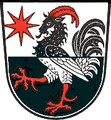Billy goat (heraldic animal)

The goat and the goat have a heraldic animal in heraldry established. For this common figure many names are in use: As a goat or billy goat , cow or bitch Bock one calls this horned animal.
Design and blazon
Whether the female or male animal of the domestic goat is depicted is of secondary importance in heraldry - in contrast to the sheep , where the lamb represents meekness or Jesus , while the ram represents strength and assertiveness.
The billy goat is shown in the basic position to the right . He can be shown running or jumping, but also upright. Its Reinforcement , so horns, hooves and tongue, can a different color ( tinged be). The animal appears as a shield holder and also erupting or growing in the upper coat of arms . The representation of only the horns is also popular .
Confusion with the ram , but also the chamois , the ibex and other horns are possible in heraldry. The description of the coat of arms must clarify it. A typical characteristic is generally the goatee .
- Keeping the billy goat
standing, naturalistic: in blue a gold-horned and hoofed, silver goat (coat of arms of Blaubach )
In the same position under a crown of St. Stephen : Kecskemét
Großbockenheim emblazoned: rising - cf. Bockenheim on the Wine Route
Bock head, right- facing in a golden shield: Beuren (near Nürtingen) ( Geißbeuren )
- to form
wrapped in cloth on the right , a goat's head in the shield on the left ( Nowogrodziec )
The goat eagle , flame- coated ( similar to a dragon , Schwarzenborn )
Ziegenhain (Schwalmstadt) ; Rooster with a goat's head
use
He has been known in the coat of arms of Hälsingland (Sweden) since 1560 . An earlier depiction of the coat of arms cannot be ruled out.
In some coats of arms the billy goat is talking. Examples are the coat of arms of Ziegenrück , Bockenheim an der Weinstrasse , Geiswiller , Hohegeiß , Caprarola (Viterbo) or Boxholm (Sweden).












